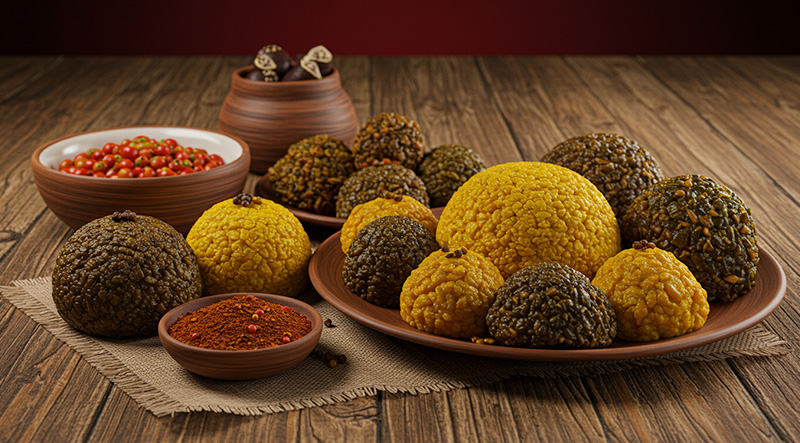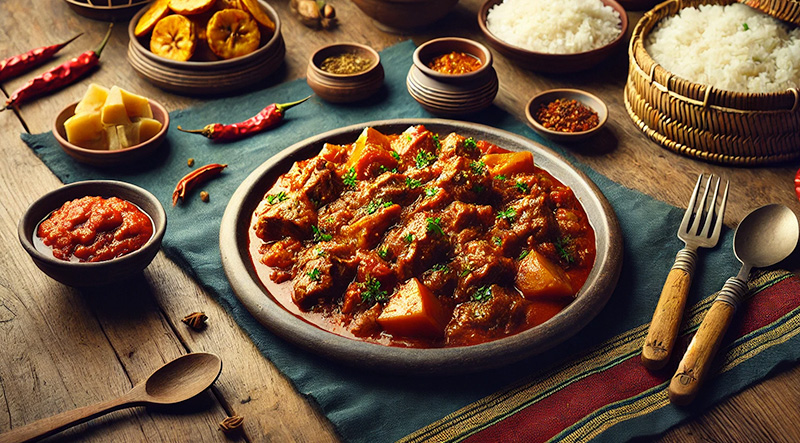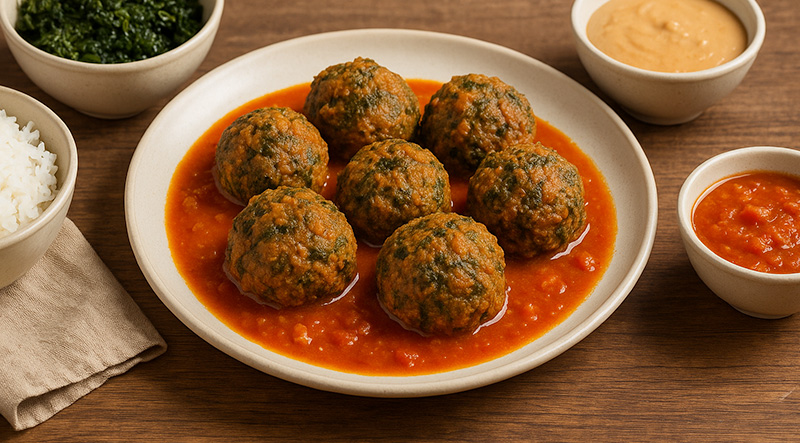Imagine tender meatballs, so soft they practically melt in your mouth, bathed in a thick, savory sauce that clings to every bite. This is Kanda, the beloved national dish of the Central African Republic, where the magic isn't cream or cheese, but the earthy richness of ground pumpkin seeds. Each spoonful is a perfect harmony of nutty, meaty, and aromatic flavors, offering a comforting and delicious taste of true Central African home cooking. Read More...
The History of Kanda: A Culinary Treasure of the Central African Republic: Kanda, the hearty and spicy meatball dish simmered in rich peanut sauce, holds a cherished place in the culinary traditions of the Central African Republic (CAR). It’s more than a national dish—it is a symbol of resilience, resourcefulness, and cultural identity. While it may seem like a simple comfort food, the roots of Kanda are deeply entwined with the history of the region, stretching back generations and reflecting the rhythms of rural life and the influence of indigenous ingredients.
Origins in Rural Life: The origins of Kanda are grounded in the agrarian communities of the Central African Republic. With cattle and goats being integral to traditional village life, ground meat became a practical and accessible source of protein. Locals began blending this meat with spices and pounding it into balls using traditional mortars and pestles—tools that remain central in many Central African kitchens today.
The use of peanuts in the dish is also significant. Introduced to Africa from South America via colonial trade routes, peanuts thrived in the CAR’s climate and quickly became a staple crop. Over time, ground peanuts were transformed into sauces that became essential in Central African cuisine. The peanut sauce in Kanda adds not only flavor but also nutrition, making the dish a perfect example of local innovation and adaptation.
Cultural and Ceremonial Importance: Kanda is not just everyday fare; it holds ceremonial importance in many communities. It is often prepared for celebrations, family gatherings, and village events. In these contexts, the act of making Kanda becomes communal—families come together to grind the meat, crush the peanuts, and simmer the sauce over open fires. The process embodies cooperation and hospitality, values that are central to Central African culture.
Colonial Influence and Evolution: During the French colonial era, many traditional Central African dishes were marginalized or altered to suit colonial tastes. However, Kanda persisted and even evolved, with new ingredients like bouillon cubes and tomato paste being added over time. Despite external influences, the dish retained its original identity—firmly rooted in local ingredients and cooking methods.
Kanda Today: In modern times, Kanda remains a culinary icon of the Central African Republic. Whether enjoyed in humble village homes or in city restaurants, it continues to bring people together across generations. As more Central African communities engage in diaspora living, Kanda is also becoming a bridge to home for those abroad—preserving a taste of tradition and heritage wherever it is made.
In every steaming plate of Kanda, there lies a story of survival, adaptation, and deep cultural pride. It’s not just food—it’s a flavorful history lesson served with love.
Prepare the Pumpkin Seed Powder:
Form the Meatballs (Kanda):
Start the Sauce Base:
Create the Pumpkin Seed Sauce:

Cook the Kanda:

The Final Simmer:

Season and Serve:
From start to finish, you can expect this Kanda recipe to take approximately 1 hour to complete. The active preparation time is relatively quick at around 20 minutes, which includes grinding the pumpkin seeds, chopping your vegetables, and rolling the meatballs. The majority of the time, about 45 to 50 minutes, is dedicated to cooking, during which the meatballs gently simmer in the sauce. This crucial, mostly hands-off simmering period is essential for the Kanda to become tender and for the sauce to develop its signature rich, nutty flavor and creamy consistency.
Based on the ingredients listed in the recipe, a single serving of this Kanda is estimated to contain between 420 and 630 calories, depending on whether the dish is divided into four large or six smaller portions. The vast majority of these calories come from the two most significant ingredients: the fat and protein-rich ground pumpkin seeds and the ground beef, with an additional contribution from the cooking oil. This calculation is for the Kanda dish itself and does not account for any side dishes like fufu, yams, or rice, which would increase the total caloric value of the meal. The final count will also vary slightly based on the leanness of your ground beef and the addition of any optional ingredients.







